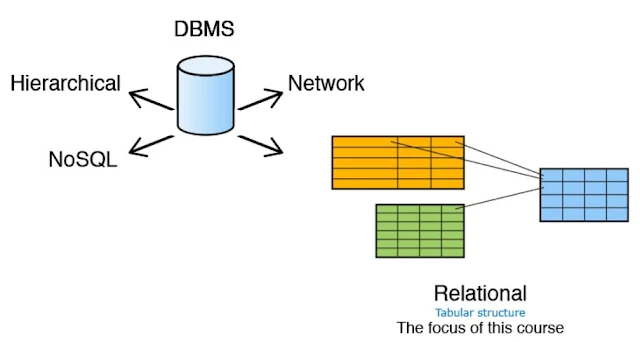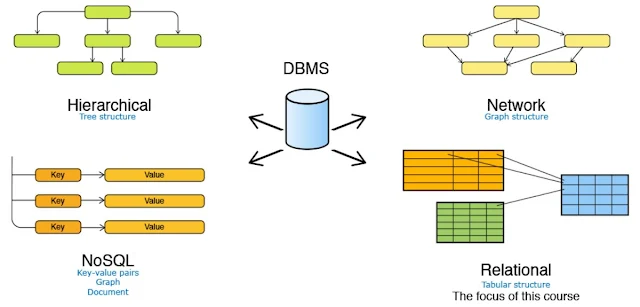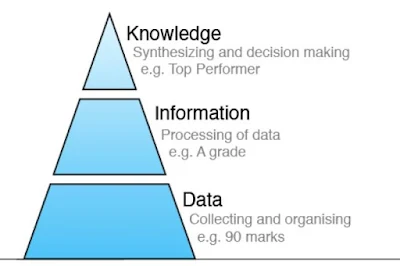Database Management System
DBMS Tutorial
Database Systems Overview
What is Data?
Before we understand Databases, we need to understand the concept of Data. Data is a collection of facts about the object of interest. For e.g. Data about an employee would include information like name, address, age, educational qualifications, etc. Software Applications need to store data as it is required to answer a question e.g. how many employees are above 40 years of age? Data is also required to convey a story e.g. why are we successful as an organization?
Data is raw, just a set of facts which by itself does not convey anything. We need to understand patterns between factual data and give it a meaning. This is called information which helps us with answers to questions like who, when, what, where, etc. Synthesis of data and information leads us to answer how to question and take business decisions. This is referred to as Knowledge.
-
Requirements from Data:
Software Applications that use data are expected to meet several requirements from end-users. Let us take the example of a Facebook application.
Requirement
|
Description
|
Integrity
|
Data should be accurate e.g. my Facebook profile should contain a valid country name.
|
Availability
|
I should be able to access Facebook and see my data at all times.
|
Security
|
Only my friends should be able to see my posts and no one else.
|
Independent of Application
|
I should be able to access the same data from my Android app as well as from the web browser on my laptop.
|
Concurrent
|
All my friends should be able to see my posts at the same time.
|
Limitations of Flat Files:
Data is stored in flat files and can be accessed using any programming language. The file-based approach suffers the following problems:
- The dependency of the program on the physical structure of data
- The complex process to retrieve data
- Loss of data on concurrent access
- Inability to give access based on record (Security)
- Data redundancy
Database Systems:
A Database is a shared collection of logically related data and description of these data, designed to meet the information needs of an organization
A Database Management System, i.e. DBMS, is a software system which is used to enables users to define, create, maintain, and control access to the database. Database Systems typically have high cost and they require high-end hardware configurations.
An Application Program interacts with a database by issuing an appropriate request (typically a SQL statement)
Quiz 1: A Database Management System is
a) Collection of interrelated data
b) Collection of programs to access data ---
Quiz 2: DBMS is an interface between
a) Database and User
b) Database application and database ---
c) Database and SQL
d) Data and Database
Quiz 3: Which of the following are disadvantages of the file system to store data?
a) Data redundancy and inconsistency ---
b) Difficulty in accessing data ---
c) Data isolation is not present ---
d) High Cost
-
-
#dbms #database_management_system #dbms_tutorial #database #database_system
-
Functions of DBMS:
Database Management Systems, i.e. DBMS, offers several functions that help us overcome problems associated with file-based systems. We will focus on Data Management, Integrity, Transaction and Concurrency in this course. Security, Recovery, and Utilities are out of scope for this introductory-level course.
Types of Database Systems:
Database Systems are categorized into four types based upon the underlying structure used to store data. These database systems in chronological order of their evolution are Hierarchical, Network, Relational, and NoSql. We will now get a brief overview of these database management systems.
Hierarchical Databases:
Hierarchical Databases organize data into a tree-like structure. Data is stored as records which are connected to one another through parent-child relationships. Some examples of Hierarchical Databases are Information Management System (IMS), Raima Database Manager (RDM) Mobile, etc.
 |
| Hierarchical Database |
Network Databases:
Network Databases organize data into a graph structure in which object types are nodes and relationship types are arcs. Each record in Network Database can have multiple parents as well as child records. Some examples of Network Databases are Integrated Database Management System (IDMS), Integrated Data Store (IDS), etc.
 |
| Network Database |
Relational Databases:
Relational Databases organizes data into one or more tables. A table consists of attributes (columns), tuples (rows) and provides a way to uniquely identify each tuple. Tables are related to each other through parent-child relationships. Some examples of Relational Databases are DB2, Oracle, SQL Server, etc.
 |
| Relational Databases |
NoSQL Database:
NoSQL (Not only SQL) database uses key-value, graph or document data structures to store data. These databases aim for simplicity of design, horizontal scaling and finer control over availability. Some examples of NoSQL databases are Firebase Real-Time, Cassandra, MongoDB, CouchDB, OrientDB, HBASE, etc.
 |
| NoSQL Database |
Additionally, there are other databases types as well like Object-Oriented databases e.g. DB4O and ZopeDB, Graph Databases e.g. Neo4J and InfiniteGraph, etc. Relational databases are the most widely used database in the current times. In this course, we will focus on Relational Databases.
 |
| Types of Database System |
Quiz 4: Which of the following features are provided by DBMS?
a) Maintain accuracy of data ---
b) Utilities for performance analysis and logging ---
c) Ensure modifications are successful or not done at all ---
d) Recovery mechanism for data ---
Quiz 5: Which of the following is an advantage of database management approach?
a) Data is dependent on programs
b) Data redundancy increases
c) Data can be accessed by multiple programs ---
d) Multiple users cannot access data concurrently
Quiz 6: Which of the following features are provided by DBMS?a) Protect data from system crash ---b) Low cost and run on commodity hardwarec) Authorized access---d) Application Dependence on storage mechanism
Relational Model:
Relational Databases store data in relations i.e. tables. Each relation must have a name.
 |
| The relation is usually represented as: Employee(ID, ENAME, SALARY, BONUS, DEPT) |
The column is known as an Attribute in a database of a relation. It stores specific information about an object e.g. salary.
A Tuple is a row in a relation. It represents the relationship between attributes that can contain a single value.
The Cardinality of a relation is the number of rows it contains. e.g. Cardinality of relation below is 4.
Degree of a relation is the number of attributes it contains. e.g. Degree of relation below is 5.
NULL represents the value of an attribute that is currently unknown or not applicable.
A Domain is a set of allowable values in the database for one or more attributes.
A collection of relations with distinct relation names is called as Relational Model.
Quiz 7: A relational database consists of a collection of
a) Tables ---
b) Fields
c) Records
d) Attributes
Quiz 8: A relationship among a set of values in a table is represented by a
a) Column
b) Attribute
c) Row ---
d) Relation
Quiz 9: The set of permitted values of an attribute is called
a) Tuple
b) Column
c) Domain ---
d) Table
Quiz 10: The attribute value that is currently unknown is
a) 0
b) NULL ---
d) ''
e) -1
Consider the relation SalesMan(SId, SName, Location)
Quiz 11: What is the cardinality of the above relation?
a) 3
b) 1
c) 4 ---
d) 2
Consider the relation SalesMan(SId, SName, Location)
Quiz 12: What is the degree of the above relation?
a) 3 ---
b) 1
c) 4
d) 2
Database Management System
DBMS Tutorial
---
I hope you likable this nice post. Do not forget to share it together with your friends, the Sharing Button is below the post. Apart from this, if there's any downside within the intermediate, don't hesitate to request the Comment Box. we are going to be happy to help you.
I will continue to write more and more on this blog, so do not forget to make our blog BlogLearner as a bookmark (Ctrl + D) on your mobile or computer and subscribe to us to get all the posts in your email. Do not forget to share these posts, if you like it. You can facilitate us reach additional individuals by sharing it on social networking sites like Facebook or Twitter.
 |
| Database Management System |




































Nice article, Which you have shared about the html tutorial. Your article is very informative and useful for those who are looking for html tutorial in hindi.
ReplyDelete